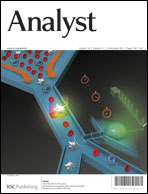Sensitive electrochemical immunoassay of metallothionein-3 based on K3[Fe(CN)6] as a redox-active signal and C-dots/Nafion film for antibody immobilization†
Abstract
The fabrication of a facile, sensitive, and versatile immunosensor for the quantification of metallothionein-3 (MT-3) is proposed in this work. The K3[Fe(CN)6]–chitosan–glutaraldehyde (K–CS–GA) conjugate prepared from K3[Fe(CN)6], chitosan and glutaraldehyde was employed as the redox-active signal source. Carbon nanodots (C-dots) were coupled with Nafion to form the nanocomposite architecture layer to carry antibodies (Abs). C-dots enhanced the electrochemical response of the proposed immunosensor to improve the detection sensitivity. The fabrication steps of the immunosensor were characterized using differential pulse voltammetry (DPV) and cyclic voltammetry (CV). Antigen determination was achieved via the decreased current response of the K3[Fe(CN)6] caused by the insulated coupled antigen. The detected signals were proportional to the logarithm of the concentrations of MT-3 ranging from 5 pg mL−1 to 20 ng mL−1 with a detection limit of 2.5 pg mL−1 in PBS. The proposed immunosensor showed high sensitivity, good selectivity and reproducibility. Furthermore, detection results using real serum samples showed the immunosensor's potential applications in clinical diagnostics.
![Graphical abstract: Sensitive electrochemical immunoassay of metallothionein-3 based on K3[Fe(CN)6] as a redox-active signal and C-dots/Nafion film for antibody immobilization](/en/Image/Get?imageInfo.ImageType=GA&imageInfo.ImageIdentifier.ManuscriptID=C3AN01351K&imageInfo.ImageIdentifier.Year=2013)

 Please wait while we load your content...
Please wait while we load your content...